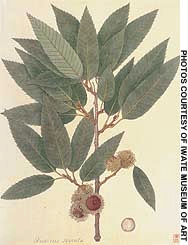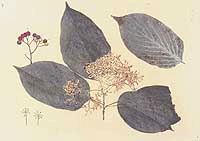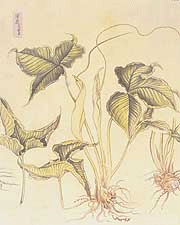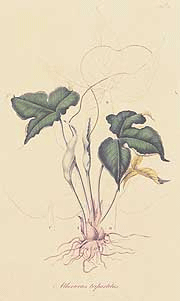Mastering the fine art of science
July 3, 2002
SIEBOLD'S BOTANICAL ILLUSTRATIONS
Mastering the fine art of science
By KATE THOMSON
Special to The Japan Times
"Japanese Botanical Art and Illustrations from Siebold's Collection," on show at the Iwate Museum of Art till July 28 (then traveling to Chiba and Tokyo), is the kind of exhibition one expects from a public museum trying to attract and please a wide audience. The creators of this show, it's tempting to speculate, were appealing to the Japanese passion for gardening and flower arranging -- and the affection with which the Bavarian-born physician and naturalist Philipp Franz von Siebold (1796-1866) is remembered here for pioneering European advancements in natural sciences in Japan, and for introducing the fascinating wealth of Japanese flora to the world.


An illustration by Muzutani Sukeroku


A European copy of an illustration by Katsuragawa
A European copy of an illustration by Katsuragawa
PHOTOS COURTESY OF IWATE MUSEUM OF ART
The exhibition displays Siebold's collection of the botanical illustrations that he commissioned from Japanese artists and the European copies that were made of them later. The collection was purchased by the Russian Academy through the Russian botanist Carl Ivanovich Maximowicz (1827-91), another important promoter of scientific interest in Japanese flora.
I went to the opening more out of a duty to support the cultural activity of Iwate than a burning desire to see a lot of pretty flower paintings. My skepticism was reflected back at me by a fellow (Japanese) artist I met there who complained that the kind of intricate detail shown in the works is not as technically demanding as the enthusiastic gallery-goers evidently thought it was.
Then I met the curator, Tamara Tchernaja of the Russian Academy, who inspired me to take a closer look. "It is very important to show this work to the art world," she said. "Many people think it belongs only to science, but it is a specialist genre developed from collaboration between two disciplines and two cultures."
Many 19th-century Japanese artists had assimilated Western techniques and principles, but on top of artistic considerations, botanical illustration imposed strict European scientific research standards. The full life cycle of a plant had to be depicted in accordance with conventions developed in the West.
Although Siebold explained these European conventions to the Japanese artists accompanying him on botanical expeditions, they had only limited access to actual examples. Accordingly, they developed new solutions based on their own artistic experience. Stylistically, they applied the abstract, planar format characteristic of Japan's aesthetic tradition, focusing on the subject rather than its spatial context. The subject was invested with an almost human character, the artist's interpretation of its living essence.
These traits are present in the illustrations of Katsuragawa Hoken (1797-1844), a talented draftsman, court physician and enthusiastic naturalist, who was well-placed to address the challenge of illustrating Japanese flora. Employing the traditional Japanese method of "poses" that reveal the "character" of the plants, he produced a "botanical scroll" depicting an intertwined stream of plants. But this lovely East Asian expression of nature's unity thwarted the botanists' goal of abstracting individual species from their habitat. Siebold and Maximowicz simply cut up the scroll and rearranged each species in taxonomic order.
Mizutani Sukeroku (1779-1833), a Japanese scientist with no great artistic skill, fulfilled the botanical requirements very effectively by adopting the European "natural printing" technique, whereby an electric current was applied to an object to galvanize its image onto a metal printing plate. Mizutani made prints of leaves, which he supplemented with hand-drawn details of the flower- and fruit-bearing stages. His stark graphic images testify to the Japanese compositional sense -- and to the country's long tradition of printmaking.
It was Kawahara Keiga (1786-1862), an elite member of the kara-e mekiki guild (set up by the government in Nagasaki in 1697 to catalog and document all goods imported to Japan) who was most successful. He created a genre that not only met the scientists' demands, but made man's inquiry into nature's complexity the central concept of the work. His style fused Japanese fine arts with elements of Western technique and the decorative realism of Chinese kara-e. Depicting both the living plant and its partitioned structures, he highlighted the specific peculiarities of each plant while the asymmetry of his composition lent the works a natural atmosphere.
Shimizu Tokoku (1841-1907) was another illustrator who used asymmetry to breath life into his elegant compositions, despite largely adapting his style to European analytical standards and the West's more subdued artistic tastes.
Most of these works -- which may have seemed incomprehensible to those unable to think outside of 19th-century European scientific and cultural concepts -- were copied by European artists for "Flora Japonica," published in 1835.
Of the original Japanese drawings, only 56 pictures (by Kawahara) were ever published. They appeared in two volumes printed by Japan Keiga Shashin So in 1836. The others remained unpublished until the issue of "Siebold's Florilegium" in 1993.
It is difficult not to regret the opportunity lost by withholding the Japanese works from a Western audience. The differences in artistic and scientific priorities are evident when the energy and atmosphere of the Japanese originals is set alongside the more static logic of the European copies. The unfortunate result was that European scientists were deprived of the chance to explore Japanese illustrators' insights into their country's native flora.
From an artistic standpoint, too, the Japanese works are challenging. Are they fine art, applied art, or scientific illustration? They share the traits of many genres, yet are unique for being perhaps the first attempt to bridge Western scientific learning and Japanese aesthetics.
Artists who undertake a complex interdisciplinary and intercultural commission face a huge challenge. This exhibition showcases Japanese artists their impressive response. The conclusion is plain for all to see: Science can stretch the boundaries of art, even as the arts expand science's imagination.
"Japanese Botanical Art and Illustrations from Siebold's Collection: The Treasures of the Library of the Russian Academy of Sciences, The Komarov Botanical Library, St. Petersburg" runs till July 28 at the Iwate Museum of Art, 12-3 Matsuhabe, Motomiya, Morioka, Iwate; call (019) 658-1711 or visit the Web site at www.ima.or.jp for more information.
The exhibition will be at the Sakura City Museum of Art, Chiba, Aug. 17-Sept 23; and Odakyu Grand Gallery, Tokyo, Dec. 26-Jan. 12, 2003. (As the works need to be protected from over-exposure to light, exhibits will rotate at different venues.)
Kate Thomson is an Iwate-based sculptor whose work can be viewed on the Ukishima Sculpture Studio Web site, www.ukishima.net
The Japan Times: July 3, 2002
(C) All rights reserved